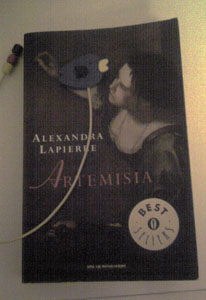With today’s book, one could say that we almost pick up the thread from the book we told you about last time, The Forbidden Books by Mario Infelise, because the events of Alexandra Lapierre’s novel Artemisia (in Mondadori’s Best Sellers edition) coincide with some of the passages in the text that talked about book censorship in Europe. We therefore already know some aspects of the historical context in which Artemisia Gentileschi lived, the great protagonist of the historical novel that the French-American author writes with passion but without forgetting historiographical rigor.
 |
| Artemisia by Alexandra Lapierre |
In fact, the first thing that strikes one about Artemisia is the precise historiographical reconstruction, and to testify to this it would be enough to browse through the substantial bibliography that closes the book and offers us several insights. A historiographical reconstruction that will be able to make us evocatively relive the atmospheres of the time by taking us into the slums of the artists’ quarter of a Rome at the end of the Counter-Reformation, into the luxury of the court of Cosimo II de’ Medici in Florence, or again among the intrigues of London in the 1730s.
It is precisely in London that the novel opens, beginning...at the close! It is February 1639 and Artemisia’s father, Orazio Gentileschi, has been missing for a few days. A long flashback then takes us back to 1599, when Artemisia is just six years old and, together with her father, witnesses a tragic episode of the time, the execution of Beatrice Cenci, which is mainly meant to frame in a dry and brutal way the historical context in which we find ourselves as well as to suggest to us what the air was like in Rome during the years of the application of Counter-Reformation principles.
Artemisia, in exactly forty years of the artist’s life, will tell us the whole story of Italy’s most famous painter, not forgetting, of course, the tragic affair of the violence she suffered from Agostino Tassi, another of the novel’s many protagonists, and going through all her transfers that made her travel around Italy (and beyond). The painters of the time are all there, although many are destined to the role of extras: Caravaggio, Giovanni Baglione, the Cavalier d’Arpino, Cristofano Allori and many others. But father and daughter stand out above them all: much of the novel centers precisely on the dualism between Horace and Artemisia.
This is a book that we definitely recommend to everyone, for several reasons. Although it is not really an art history book, and perhaps this may turn the nose up at our more purist readers, it offers, as already mentioned, a rigorous reconstruction from both the historical and art-historical points of view, although obviously, since it is a novel, good space is devoted (although not very large) to the dialogues, always respecting the historical events and without excessive inventions on the part of the author. The result is a book for everyone, which does not require prior knowledge of the subject (either history or 17th-century art) in order to be best understood, because Alexandra Lapierre provides the reader with all the tools he or she needs to understand the story.
So, in spite of the subject matter, which may seem hostile, a novel that is very easy to read and can also be a useful tool to bring the reader closer to the history of art: I am sure that all of you who read it will eventually be curious to see the works described during the narrative live. That’s right, the works: the chapters of the book bear the names of some of Artemisia Gentileschi’s greatest masterpieces, and in the edition we offer you will also find pictures of the paintings discussed throughout the novel!
So if you are in the mood to read a book that is absolutely undemanding, definitely interesting and written with great passion and at the same time with care and respect for history, and that maybe can also teach you something, Artemisia by Alexandra Lapierre is the book for you: You will relive the story of one of the greatest protagonists of our art, Artemisia Gentileschi, and at the end of each page you will always be curious to know what happens in the next lines, such is the wisdom with which Alexandra Lapierre tells us the story: and this even if you are deep connoisseurs of Artemisia Gentileschi’s biography and painting!
Artemisia
By Alexandra Lapierre
Best sellers Mondadori, 2000 (first edition 1999)
511 pages
10,50 €
Warning: the translation into English of the original Italian article was created using automatic tools. We undertake to review all articles, but we do not guarantee the total absence of inaccuracies in the translation due to the program. You can find the original by clicking on the ITA button. If you find any mistake,please contact us.